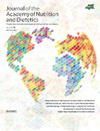Development and Preliminary Evaluation of a Food Literacy Measure for Use With Young People in Canada
IF 3.5
2区 医学
Q2 NUTRITION & DIETETICS
Journal of the Academy of Nutrition and Dietetics
Pub Date : 2024-11-04
DOI:10.1016/j.jand.2024.10.021
引用次数: 0
Abstract
Background
This article presents the culmination of a multiyear research project aimed at creating a comprehensive food literacy framework and corresponding measure. Specifically, this article documents the development and validation of a food literacy measure for young people facing social inequities.
Objectives
This study aimed to identify items to measure 12 attributes of food literacy; test the measure with the identified target groups, considering attribute, face, and content validity, inter-rater reliability and test-retest reliability; and refine the measure.
Design
The study’s design consisted of a 5-phase approach that included drafting the food literacy measure, expert review, cognitive interviews, pilot testing, and validity and reliability testing.
Participants and setting
Seven international experts provided feedback on the measure, and 25 individuals aged 16 to 25 years participated in cognitive interviews. Two hundred fifty-five young people completed the test survey, and 147 completed a retest survey 2 weeks later. These surveys identified food literacy factors. To further evaluate the validity of these factors, 193 participants completed a confirmatory test that was used for confirmatory factor analysis to assess the final model’s fit. Interview participants were recruited from local programs and services from across Ontario, Canada, and survey participants were recruited from across Canada via social media. The research study was conducted between January 2018 and December 2019.
Main outcome measures
The main outcome measures were validity and reliability scores for a food literacy measurement tool that consisted of 50 questions across 10 attributes of food literacy.
Statistical analyses performed
Interview analyses were guided by the 4 stages of cognitive processing. Exploratory factor analysis was used to identify the factors that improved the Cronbach's alpha of the food literacy measure. Test-retest reliability was assessed using percent agreement, Cohen's kappa, and weighted kappa. Confirmatory factor analysis was used to produce an acceptable final model with a root mean square error of approximation estimate.
Results
The final food literacy measure consisted of 50 questions addressing 10 food literacy attributes. Exploratory factor analysis showed an improvement in Cronbach's alpha when compared with the initial attribute construction. Test-retest reliability showed percent agreement ranging from 64% to 97%, with most items having fair (0.21 to 0.40) to moderate (0.41 to 0.60) kappa values. Confirmatory factor analysis produced an acceptable final model with a root mean square error of approximation estimate of 0.0437.
Conclusions
The food literacy measure is a comprehensive tool for assessing food literacy among young people. Additional research is needed to explore the measure's modularity, its use as an evaluation tool, and its suitability for use with diverse samples, including individuals from varied gender, geographic locations, ethnicities, and cultural backgrounds.
开发并初步评估用于加拿大青少年的食品知识测量方法。
背景:本文介绍了一个多年研究项目的成果,该项目旨在建立一个全面的食品素养框架和相应的衡量标准。具体而言,本文记录了针对面临社会不平等的年轻人的食物素养测量方法的开发和验证过程:本研究旨在1)确定测量食物素养 12 个属性的项目;2)在确定的目标群体中测试该测量方法,考虑属性、表面和内容效度、评分者之间的可靠性和测试-再测可靠性;以及 3)完善该测量方法:研究设计分为五个阶段,包括起草食物素养测量方法、专家评审、认知访谈、试点测试以及效度和信度测试:七位国际专家对测量方法提供了反馈意见,25 名 16-25 岁的个人参加了认知访谈。255 名青少年完成了测试调查,147 名青少年在两周后完成了复测调查。这些调查确定了食品知识因素。为了进一步评估这些因素的有效性。193 名参与者完成了确认测试,该测试用于确认因素分析 (CFA),以评估最终模型的拟合度。访谈参与者是从加拿大安大略省各地的地方项目和服务机构招募的,而调查参与者则是通过社交媒体从加拿大各地招募的。研究在 2018 年 1 月至 2019 年 12 月期间进行:主要结果测量指标是食物素养测量工具的有效性和可靠性得分,该工具由 50 个问题组成,涉及食物素养的 10 个属性:访谈分析以认知处理的四个阶段为指导。探索性因子分析(EFA)用于确定可提高食物素养测量工具 Cronbach alpha 的因子。使用一致性百分比、科恩卡帕和加权卡帕评估测试-再测可靠性。使用确证因子分析(CFA)建立了一个可接受的最终模型,并对 RMSEA 进行了估计:最终的食品素养测量包括 50 个问题,涉及 10 个食品素养属性。EFA 显示,与最初的属性构建相比,Cronbach alpha 有所提高。测试-再测信度显示出 64% 到 97% 的一致性,大多数项目的 Kappa 值为一般(0.21-0.40)到中等(0.41-0.60)。CFA 得出了一个可接受的最终模型,RMSEA 估计值为 0.0437:食物素养测量是评估青少年食物素养的综合工具。还需要进行更多的研究,以探讨该测量方法的模块化、其作为评估工具的用途,以及是否适合用于不同的样本,包括来自不同性别、地理位置、种族和文化背景的个人。
本文章由计算机程序翻译,如有差异,请以英文原文为准。
求助全文
约1分钟内获得全文
求助全文
来源期刊

Journal of the Academy of Nutrition and Dietetics
NUTRITION & DIETETICS-
CiteScore
7.20
自引率
10.40%
发文量
649
审稿时长
68 days
期刊介绍:
The Journal of the Academy of Nutrition and Dietetics is the premier source for the practice and science of food, nutrition, and dietetics. The monthly, peer-reviewed journal presents original articles prepared by scholars and practitioners and is the most widely read professional publication in the field. The Journal focuses on advancing professional knowledge across the range of research and practice issues such as: nutritional science, medical nutrition therapy, public health nutrition, food science and biotechnology, foodservice systems, leadership and management, and dietetics education.
 求助内容:
求助内容: 应助结果提醒方式:
应助结果提醒方式:


